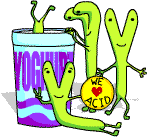A Drop Of Culture, Making Yoghurt and Labna
Created | Updated Jun 27, 2013

Eating micro-organisms isn't always as scary as it sounds. Although the bugs that cause food poisoning are continually in the news, the trillions of friendly micro-organisms that inhabit our food go about their business unheralded. In fact, several of our favourite consumables, including bread, soy sauce, wine and cheese, owe their very existence to micro-organisms, which, in the world of food, are more often called yeasts, ferments or cultures.
Yoghurt1 is one popular food seething with living organisms and one of the few cultured foods whose manufacturers are proud to proclaim the fact. The words acidophilus and bifidus - the names of two of the several different lactic acid2 bacteria that are capable of converting milk into yoghurt - are prominently displayed on many yoghurt pots.
Among the milk-drinking nations, English-speaking countries were among the last to learn about yoghurt, which has been an ordinary part of the diet of most Europeans for hundreds, if not thousands of years. They are now making up for it, with metres of supermarket shelving devoted to the many different types available.
The tart flavour of yoghurt is more palatable to many people than the sweet milkiness of fresh milk and also provides a nice balance to the sweetness or richness of many other foods. The thick consistency of yoghurt, which can resemble anything from cream to custard, helps it to slip easily down the throat. Recently, yoghurt that has been left to drain in a muslin cloth until it is thick enough to stand a spoon up in, has become very popular. It is often referred to as Greek-style yoghurt.
You can also take the draining process a step further and make labna, or yoghurt cheese, which is as thick as cream cheese. The labna is then rolled into small balls and left to marinate for a few hours or days in olive oil flavoured with herbs. These little balls can then be served for lunch with roasted red peppers, olives, fried zucchini3 with mint and a loaf of crusty bread.
A Recipe for Labna
Ingredients
- 1 cup plain yoghurt
- 1 teaspoon salt
- Olive oil
- Rosemary leaves
Method
Take a square of fine piece of muslin or a clean white handkerchief and use it to line a small bowl.
Mix the yoghurt and salt together and pour into the muslin. Pull the edges of the muslin together and tie with a string to form a bag, or use the muslin to line a small sieve placed over a bowl.
Tie the bag to a rack in the fridge and put a bowl underneath or put the muslin-lined sieve and bowl in the fridge and leave to drip for 48 hours.
By now the yoghurt will be just firm enough to roll into small balls. Rub your hands with olive oil if the labna is very soft. Place the balls in a single layer in a shallow bowl or plastic container and pour over enough oil to almost cover.
Add several small sprigs of fresh rosemary, cover the bowl or container and store in the fridge for up to a week or so.
Labna Salad
Balls of labna are also excellent in a salad such as this one from the café in the State Art Gallery in Adelaide, South Australia.
Recipe
- Young leaves of radicchio or witloof, or other strong-flavoured salad greens, such as rocket or watercress
- 1 cup dressing made with olive oil and cider vinegar
- 1 small beetroot, cooked, peeled and diced
- 1 teaspoon caster sugar
- 4-5 labna balls, as described above
- 6-10 fresh walnut halves, lightly roasted
Method
Toss the leaves in most of the dressing and spread out on a plate. Pour the rest of the dressing over the diced beet- root, stir in the caster sugar and spoon over the leaves. Carefully lift the labna balls on to the salad and add the roasted walnuts. Eat.
Please Note: h2g2 is not a definitive medical resource. If you have any health concerns you must always seek advice from your local GP. You can also visit NHS Direct.

